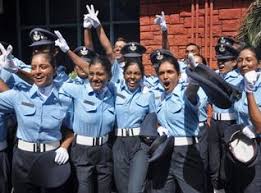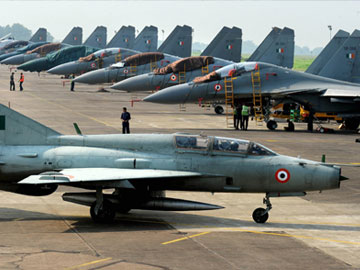The below reproduced article on women officers, authored by Maj Gen Raj Mehta, was published in Geopolitics.
Psychological and Physiological Concerns
CONTRARIAN VIEWS FROM VENUS
ARE WOMEN CLOSER TO FRONT-LINE COMBAT?
Maj Gen Raj Mehta, AVSM, VSM (Retd)

In a dramatic policy shift on 24 January 2013, outgoing US Defence Secretary Leon Panetta lifted the 1994 military ban on women serving in combat. This landmark initiative will allow uniformed women to be closer to front-line combat roles from mid 2013 onwards - unless there is strong opposition in the US
***
The recent American announcement allowing uniformed women to enter the hitherto ‘male only’ preserve - the combat zone - has aroused strong emotions worldwide. The male-dominated military world is not excited and a flood of articles have questioned the validity of the policy change. Understandably, women’s rights activists and equal-opportunity enthusiasts the world over are delighted because another male bastion has fallen by the way side. A dispassionate analysis however reveals that the forward movement to “officially” allow uniformed women to enter combat is in actuality a small, breakaway step from the otherwise glacial evolution of allowing American women to enter hardcore combat. It has, however, stopped short of officially allowing women to serve in combat. The fine-print of the policy change allows women to be permanently assigned to a combat battalion as radio operators, medical officers/orderlies, tank mechanics and other critical jobs; assignments barred by the now-rescinded 1994 combat exclusion policy which prohibited women from being assigned to ground combat units.
A Reality Check - Are Women Closer to Combat Now?
That combat exclusion, was, in real terms, never strictly applied by the US America Iraq and Afghanistan US
The consuming desire to allow women in combat roles in-so-far as women activists, uniformed women and the female gender in general, is widespread. The men, world-wide are, however, nowhere near as enthusiastic or as supportive of the landmark US
THE CASE AGAINST WOMEN IN COMBAT
Opinions justifying exclusion of women from combat have coalesced around deep-rooted concerns explained in the succeeding text.
Physical Concerns
Female soldiers are in general, smaller and lighter than male peers, have almost half their upper body strength and 25-30% less aerobic capacity; making their endurance ability far lesser than men. The female skeletal system is less dense and more prone to breakages; in particular to stress fractures. There are concerns too, that women pilots do not cope with g-forces as well as male pilots do. Naval opinion undermines women as submariners because of their need for more space; separate toilets; problems of “hot bunking” (sharing bunks with male peers on shift basis; the word “hot” meaning that the bunk retains the warmth of the last occupant). Estimates pitch the additional cost of catering as a costly $300,000 per women submariner.
Psychological and Physiological Concerns
The perceived negative impact of a combat unit's esprit de corps if a woman peer is wounded or taken prisoner/molested is cited as a key reason for women to be excluded from front-line combat. The Israeli Defence Forces report soldiers going berserk and exhibiting “uncontrollable, protective, instinctual aggression” on such occasions. There is also the fear of women ruining male bonding by bringing in romance and its stressful/competitive fall-outs. Increased pregnancy risks; attendant social disruption and women using their bodily functions and pregnancy to escape combat situations are serious add-on issues. The issue of a woman’s instinctive underpinnings to nurture and preserve life rather than take it makes men feel women will always be squeamish about killing and bloodshed; an unavoidable fallout of combat.
CONTRARIAN VIEWS FROM VENUS
Uniformed Women are wired to do well
Opinions about women’s ability to cope with combat are not just driven by rhetoric but, equally, by research. A 2008 study by Jennifer Silva of female students enrolled in the US Reserve Officers' Training Corps program found that female cadets saw military training as an "opportunity to be strong, assertive and skillful" and "as an escape from the negative aspects of traditional femininity". The study reported that female cadets "were hyper-vigilant about their status as women performing tasks traditionally seen as men's work”. It is already well known, of course, that women as a gender are far more conscientious than men; are more honest and have far better communication skills; reinforcing IQ with Emotional Intelligence (EI); an asset that women use routinely and men sparingly, and whose possession could be a valuable life skill.
Women don’t always have to involve in Close Combat
While the Army assertion about women performing physical tasks with noticeably lesser competence than men is indisputably correct, it seems obtuse and archaic to demand that both sexes should be tested by the same yardsticks and female physiology remain the overriding factor in determining women’s combat worth. In an Indian tank regiment of around 650, for instance, only about 200 soldiers actually enter combat as tank crews; with another approximately 200 involved in supporting tasks where the risk of close combat is lesser though still real. That leaves about 250 soldiers who, though in the combat zone, will rarely be involved with warfighting. The implication is clear; women pitched into a combat zone do not have to be “like the boys”. They can still earn professional respect in the roles that US
Air Force and Naval Issues
So far as the Air Force is concerned, there is indisputable medical evidence that male pilots are less able to handle g-forces than female counterparts since women are less likely to suffer black-outs due to shorter blood vessel routes in the neck. This does not make men lesser relevant but it certainly makes women pilots more relevant. No wonder then, that western air forces and even the Pakistani Air Force now allow women to fly fighter aircraft. Even conservative India
Can Women Warriors Cope with Combat?
The question of women being brutalized if captured is, of course, real. That said, the brave attitude of Major Rhonda Cornum, now a Brigadier General is worth noting. She was taken prisoner by the Iraqi’s during the Gulf War in 1991. Asked not to mention that she had been molested, Cornum subsequently disclosed the attack, but said "A lot of people make a big deal about getting molested," adding: "But, in the hierarchy of things that were going wrong, that was pretty low on my list". In 2007, author Kirsten Holmstedt released Band of Sisters: American Women at War in Iraq. The book presents twelve stories of American women on the frontline including America
The history of warfighting also supports the contention that women can become skillful in combat. In World War 2, the Red Army of Russia had about 4,00,000 women serving as tank crew, infantry, snipers, military police, medics and nurses. Roza Shanina, a Soviet sniper during World War 2, was credited with 54 confirmed ‘kills’. Between 1942 and 1945, 12% of Russian fighter pilots were female. Britain’s Special Operations Cell trained 418 female agents as spies of which 119 were shot, including Noor Inayat Khan; an Indian and a direct descendent of Tipu Sultan.
The Indian Situation – No Combat for Women
Indian readers are aware that warrior women have been an important part ofIndia
Indian readers are aware that warrior women have been an important part of
Defence Minister AK Anthony has, in a written Lok Sabha response indicated that, in September 2012, the Army was short of 10,100 officers; the Navy 1,996 and the IAF 962; totaling 13,058 officers. Women officers comprise a mere 3.3 percent of Army officer strength; 3.9 percent in the Navy but a healthy 10 percent in the Air Force. Women officer strength, 21years after their recruitment first began in 1992, is 1,214 in the Army, 302 in the Navy and 1,079 in the IAF. These numbers exclude lady medical and nursing officers. The Army recruits women officers in the Signals, Engineers, Army Aviation, Army Air Defence, Electronics and Mechanical Engineers, Army Service Corps, Army Ordnance Corps, Intelligence Corps, Army Education Corps and Law branches. The Navy recruits them into the Law, Logistics, Observer, Air Traffic Controller, Naval Constructor and Education branches. In the IAF, though, women officers are recruited in all branches and streams, except the fighter stream of the flying branch.
Rejecting the combat-role-for-women demand, the Government has cited the HQ Integrated Defence Staff (IDS) report of 2006 and the Tri-Services Committee report of 2011. Women are currently recruited as SSC officers for five years extendable to 14 years of service. Permanent commission is however available in the Law and Education branches of the Services and a few additional technical branches in the Navy and IAF.
Indian Women Officers Deserve Better
The author has seen women officers in uniform perform with displayed capability in the war zone in J&K for over a decade. He found them spirited, conscientious, gutsy, principled, honest and reliable; capable of sustained hard work at par with male peers. That they could not be tested under fire is no slur on their capability or potential simply because the current rules forbid entry into combat. That said, our crippling officer shortages have often compelled us to “unofficially” use them in the war zone in certain roles. The author did not come across any woman officer who backed out by quoting rules or regulations. They have carried out assigned military tasks as well as men have; assisted in rural development, schooling, women care; running orphanages, schools, child care projects in “black areas” where they were vulnerable to combat situations - with as much courage as their male peers. Tested in weapon firing; during Engineer bridging camps; night parades and exercises, they have displayed adequate soldierly capability. In May 2012, seven women officers climbed Mount Everest ; all being honoured by the President of India for their world class performance.
While actual combat in the Indian case is a long way off; certainly farther than it is in USA
Courtesy: Major Navdeep Singh
Courtesy: Major Navdeep Singh



